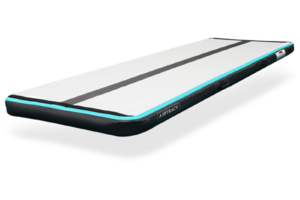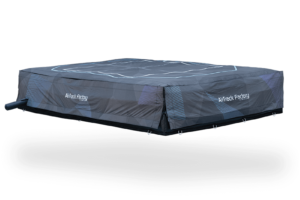AirTrack Mats in Trampoline Parks
AirTrack mats have their history in traditional gymnastics and tumbling gyms. The fact that they were filled with air brought benefits to reducing training injuries, flexibility in setups, placement around the gym, and faster transitions to the spring floor due to the similarities in technique and timing compared to the slower elongated techniques that tumbling trampolines required.
With the rise of trampoline and freestyle parks we’ve seen a tremendous increase in adoption of these traditional air training devices into new environments accompanied with new and innovative setups. I don’t think intuitively this surprises anyone with any experience in gymnastics or tumbling. However, it’s still worth asking the question, why? What is the benefit that athletes intuitively feel and owners have picked up on?
The three most powerful driving forces as we’ve experienced are: Attracting a new type of customer, Pressure to differentiate facility, services, and activities, and low cost compared to similarly sized attractions.
Attracting a new type of customer
Traditional trampoline parks have their limitations – mainly – the trampoline. Keep in mind that the trampoline has 2 things working against it. The vast number of tramp tricks are out of physical and talent reach of most trampoline park attendees compounded by the black bed of trampolines being designed to reduce top height reached. Bed area was shrunk with a nod to attendee safety, the trampolines themselves add an additional level of limitation to tricks and activities.
What you’re left with is a narrow space of activity that resonates with a specific segment of younger kids with average to below average physical abilities – to be fair, a massive market still.
Installing an AirTrack mat creates a space that opens the door to new tricks and activities which in turn attracts a new demographic – the practicing athlete. More specifically, we’re talking about cheerleaders, gymnasts, martial art trickers, dance acrobatics, and circus artists.
These new customers are able to bring their skills and tricks – which don’t normally translate well to the trampoline – now to the park. I’m referring to skills like: extended tumbling, handstands, simple cartwheels, traditional forward rolls, back walk overs, off-angle flipping, and twisting with reduced fear of careening out of control.
Perfect examples from Flip N Fly and KTR
These practicing athletes now have a “reason” to go to the park. Whether it’s to get additional training in or show off for friends or family they can do what they couldn’t do before given the limitations of the trampoline.
Pressure to differentiate facility, services, and activities
Attendance fatigue is a very real challenge parks run into. That fatigues puts pressure on owners and GMs to mix things up, keep things fresh. This is where the AirTrack excels.
Lets illustrate the simple point with a thought game imagining how the AirTrack is used by minute, by day.
At any point in time on the AirTrack a cheerleader does a tumbling pass, quickly followed by a martial arts trick doing a swing through. The court monitor might then organize a relay race for a group of 5 year old’s followed by a game of dodge ball with 15 year old’s. Afterward foam blocks are pulled on top of the AirTrack mat and a complete parkour course is created in the span of a few minutes.
Zooming out, the GM moves the AirTrack from one side of the park to the other giving the facility a fresh look from a Thursday to a Friday. And finally, the Owner deflates the AirTrack and brings it to the town Art & Wine festival for a marketing and outreach opportunity that Saturday.
The AirTrack’s main attribute is it’s flexibility. Flexibility of activities that can be done on the mat. Flexibility in the customer base that interacts with the attraction. Flexibility of it’s physical placement in or around your facility. That flexibility gives your facility, your staff, and your services the opportunity to adapt in ways that steel structures are unable.
Low cost compared to similarly sized attractions
New attractions are expensive. Attractions that take up a substantial footprint are doubly so. Value and “bang for your buck” are extremely important. Through put rates and usage percentage all have to be considered.
Groups are finding that an AirTrack mat can compliment or even rival the main tramp court as a standard baseline attraction that appeals to a wide base of customers while also accommodating higher usage and faster through put. By any metric, zip-lines, ninja warrior courses, warped walls, and parkour courses can’t match an AirTrack attraction.
This is only strengthened when you’re considering a renovation or replacement. Budgets become tighter and decisions all the more important.
Baseline costs for an AirTrack may start you around $2900 with larger mats running ~$8000. Which ever direction you go, the AirTrack matches up well against other trending attractions.
Summary
The list of high profile parks that are installing AirTracks is undeniably growing. These recreational facilities are seeing the benefits that traditional training facilities have enjoyed for decades. As attraction movements go, it is worth your consideration – www.airtrackus.com
You can find a growing gallery of projects here.

 408-569-9504
408-569-9504






